ASUS ZenBook Pro 15 OLED (UM535) review – great display complemented by powerful hardware
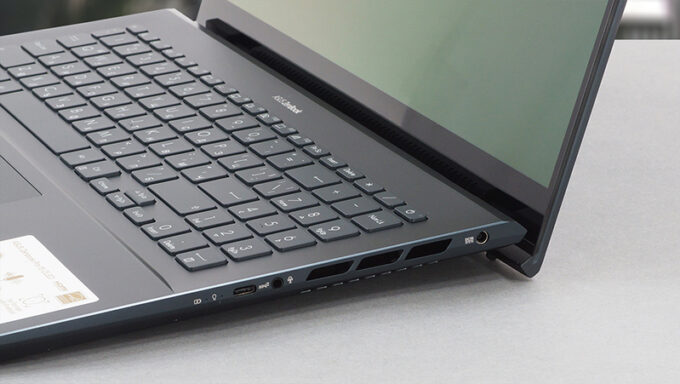 ASUS has a very wide range of ZenBook laptops on offer. Some of them are strictly for business purposes – like the ZenBook 14 UX425, while others are absolute beasts – the ZenBook Pro Duo 15 OLED (UX582) for example. And there is the third option – low-key content creator devices, which bring a lot of power to the table, but stay efficient, while their design doesn’t scream in your face.
ASUS has a very wide range of ZenBook laptops on offer. Some of them are strictly for business purposes – like the ZenBook 14 UX425, while others are absolute beasts – the ZenBook Pro Duo 15 OLED (UX582) for example. And there is the third option – low-key content creator devices, which bring a lot of power to the table, but stay efficient, while their design doesn’t scream in your face.
One such notebook is the ZenBook Pro 15 OLED (UM535). Obviously, the main event is part of the naming scheme and is the OLED display. You can pick from a Full HD, or a 4K panel, both of which come with full DCI-P3 color coverage, and HDR True Black certifications. Also, the colors are PANTONE Validated, which should make designers happy. Ultimately, it is great to see that there is not a big differentiation between the two options as ASUS is giving you the opportunity to choose the best resolution that suits your needs.
It would be great to back the display up with some decent hardware, right? Well, you shouldn’t be worried, as you can spec the device with up to the Ryzen 9 5900HX. What makes it even better is that you can pair this fantastic CPU with an RTX 3050 Ti with 50W of TGP. This will let you step up your video-editing game, and it will provide you with a lot of gaming opportunities.
You can check the prices and configurations in our Specs System: https://laptopmedia.com/series/asus-zenbook-pro-15-oled-um535/
Contents
Specs Sheet
- HDD/SSD
- up to 8000GB SSD
- M.2 Slot
- 1x 2280 M.2 NVMe slot See photo
- RAM
- up to 32GB
- OS
- Windows 11 Home, Windows 10 Home, Windows 11 Pro, Windows 10 Pro
- Battery
- 96Wh, 6-cell
- Body material
- Aluminum
- Dimensions
- 354 x 238 x 17.8 - 18 mm (13.94" x 9.37" x 0.70")
- Weight
- 2.00 kg (4.4 lbs)
- Ports and connectivity
- 1x USB Type-A
- 3.2 Gen 1 (5 Gbps)
- 1x USB Type-C
- 3.2 Gen 2 (10 Gbps)
- HDMI
- 2.0b
- Card reader
- MMC, SD, SDHC, SDXC
- Ethernet LAN
- Wi-Fi
- 802.11ac
- Bluetooth
- 5.0
- Audio jack
- 3.5mm Combo Jack
- Features
- Fingerprint reader
- optional
- Web camera
- HD IR with Windows Hello
- Backlit keyboard
- Microphone
- Array Microphone with Cortana and Alexa voice rec.
- Speakers
- Speakers by SonicMaster, ICEpower
- Optical drive
- Security Lock slot
All ASUS ZenBook Pro 15 OLED (UM535) configurations
What’s in the box?
Inside the package, you will find the mandatory paperwork, as well as a 150W power adapter.
Design and construction
Let’s start the analysis by saying that this notebook is built like a tank. Aluminum is used for both the base and the lid, while the screen sports a glass cover. This makes the entire assembly super resistant to flex. Good job, ASUS. In terms of measurements, we are talking about a profile of 18mm and a weight of 2 kilos.
Here, the hinges seem to be a bit too tight, which makes the opening process impossible with a single hand. Nevertheless, once we get it opened, we find out that the ErgoLift mechanism is present. It is pretty aggressive, as well, since it lifts the backside of the base, as soon as it gets to about 70° of opening angle. Also, we see pretty slim bezels around the glossy display, with the top one housing an HD Web camera with an IR sensor for Windows Hello login.
Let’s move to the base now, and take a look at the full-sized solution for the keyboard. It has a NumberPad segment, as well as a backlight. The keycaps are rather large, with good spacing, long key travel, and clicky feedback. Ultimately, it is amongst the more comfortable units for typing.
We are a bit disappointed by the size of the Arrow keys. On the other hand, it is good to see that there is a shortcut button that launches the MyASUS app. From there, you can control stuff like the performance presets, or choose between set profiles for the display.
Although the touchpad looks a bit small for this screen size, it is actually pretty accurate, while the glass surface ensures a smooth gliding experience.
The speakers here can be found on the bottom panel. There, you will also see a ventilation grill. Interestingly, the hot air is being pushed away from the chassis, through two gaps on either side of the device.
Ports
On the left side, there is a USB Type-A 3.2 (Gen. 1) port, an HDMI 2.0b connector, and an SD card reader. Then, on the right, you get the power plug, an audio jack, and a USB Type-C 3.2 (Gen. 2) port (which can only be used for data transfer).
Disassembly, upgrade options and maintenance
To get inside of this laptop, you need to undo 11 Torx-head screws. Then, remove the two back rubber feet, and undo the two Phillips-head screws hiding beneath them. After that, pry the bottom panel with a plastic tool and lift it away from the chassis.
Inside, we see a huge 96Wh battery pack. It managed to last us for the whopping 17 hours of Web browsing, or 16 hours of video playback. If you need to remove it, you will be happy to hear that the process is extremely easy. First, unplug the battery connector. Then, undo the two Phillips-head screws holding it to the chassis, and take it away.
Here, the memory is soldered to the motherboard. You get either 16 or 32GB of LPDDR4x memory, working at 4267 MHz. Storage-wise, there is one M.2 PCIe x4 slot.
As for the cooling, you get two heat pipes, shared between the CPU and the GPU. They connect to two side-mounted heat sinks, where two fans blow the heat away. There is a third additional heat pipe, managing the thermals of the VRMs.
Display quality
ASUS ZenBook Pro 15 OLED (UM535) is equipped with an AMOLED panel, Samsung ATNA56YX03-0 (SDC4161). Its diagonal is 15.6-inch (39.62 cm), and the resolution – 1920 x 1080p. Additionally, the screen ratio is 16:9, the pixel density – 142 ppi, their pitch – 0.18 x 0.18 mm. The screen can be considered Retina when viewed from at least 60 cm (from this distance, the average human eye can’t see the individual pixels).
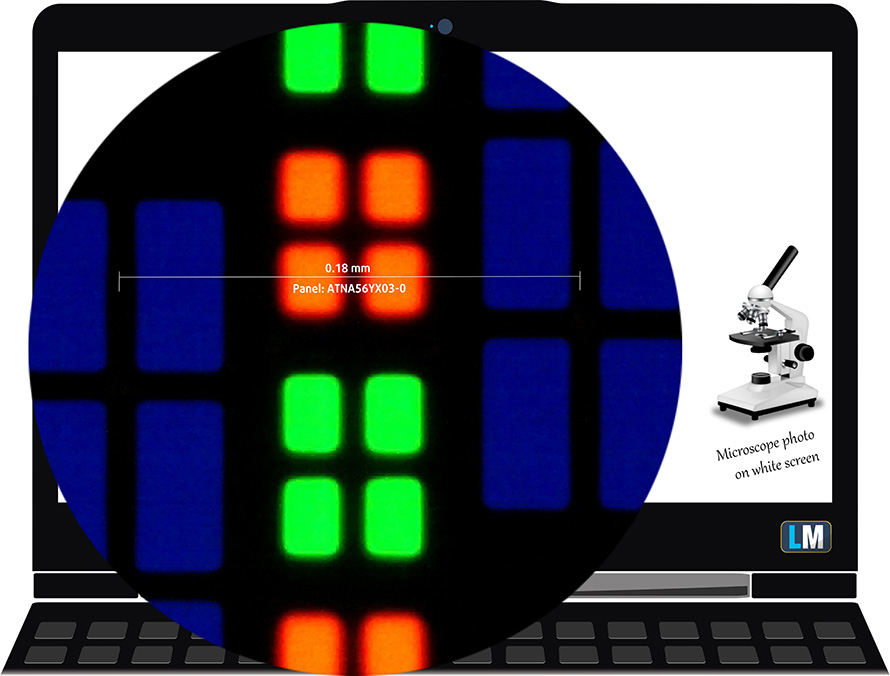
Viewing angles are comfortable. We offer images at different angles to evaluate the quality.

Also, a video with locked focus and exposure.
The maximum measured brightness is 392 nits (cd/m2) in the middle of the screen (HDR off). The Correlated Color Temperature on a white screen and at maximum brightness is 6300K – close to matching the 6500K temperature for sRGB.
In the illustration below you can see how the display performs from a uniformity perspective.
Values of dE2000 over 4.0 should not occur, and this parameter is one of the first you should check if you intend to use the laptop for color-sensitive work (a maximum tolerance of 2.0 ). The contrast ratio here is incomparably better than that of the IPS and TN panels and is mathematically infinite.
To make sure we are on the same page, we would like to give you a little introduction to the sRGB color gamut and the Adobe RGB. To start, there’s the CIE 1976 Uniform Chromaticity Diagram that represents the visible specter of colors by the human eye, giving you a better perception of the color gamut coverage and the color accuracy.
Inside the black triangle, you will see the standard color gamut (sRGB) that is being used by millions of people on HDTV and on the web. As for the Adobe RGB, this is used in professional cameras, monitors, etc for printing. Basically, colors inside the black triangle are used by everyone and this is the essential part of the color quality and color accuracy of a mainstream notebook.
Still, we’ve included other color spaces like the famous DCI-P3 standard used by movie studios, as well as the digital UHD Rec.2020 standard. Rec.2020, however, is still a thing of the future and it’s difficult for today’s displays to cover that well. We’ve also included the so-called Michael Pointer gamut, or Pointer’s gamut, which represents the colors that naturally occur around us every day.
The yellow dotted line shows ASUS ZenBook Pro 15 OLED (UM535)’s color gamut coverage.
Its display covers 100% of the sRGB/ITU-R BT.709 (web/HDTV standard) in CIE1976 and 100% of DCI-P3 providing a punchy and vibrant image.
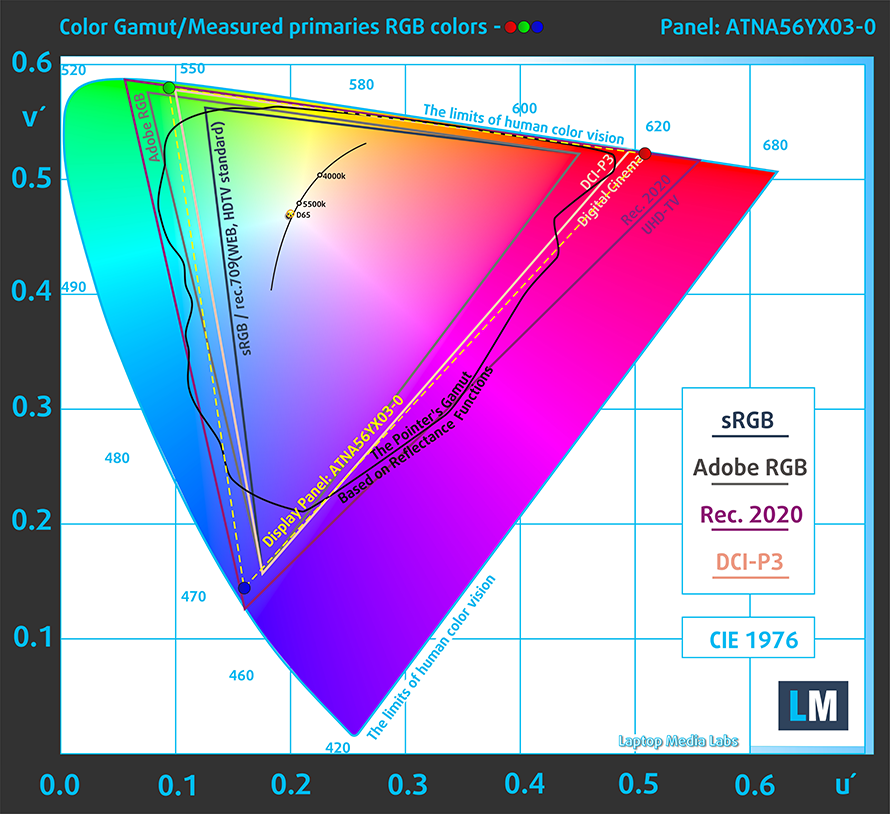
Our “Design and Gaming” profile delivers optimal color temperature (6500K) at 140 cd/m2 luminance and sRGB gamma mode.
We tested the accuracy of the display with 24 commonly used colors like light and dark human skin, blue sky, green grass, orange, etc. You can check out the results at factory condition and also, with the “Design and Gaming” profile.
Below you can compare the scores of ASUS ZenBook Pro 15 OLED (UM535) with the default settings (left), and with the “Gaming and Web design” profile (right).
The next figure shows how well the display is able to reproduce really dark parts of an image, which is essential when watching movies or playing games in low ambient light.
The left side of the image represents the display with stock settings, while the right one is with the “Gaming and Web Design” profile activated. On the horizontal axis, you will find the grayscale, and on the vertical axis – the luminance of the display. On the two graphs below you can easily check for yourself how your display handles the darkest nuances but keep in mind that this also depends on the settings of your current display, the calibration, the viewing angle, and the surrounding light conditions.
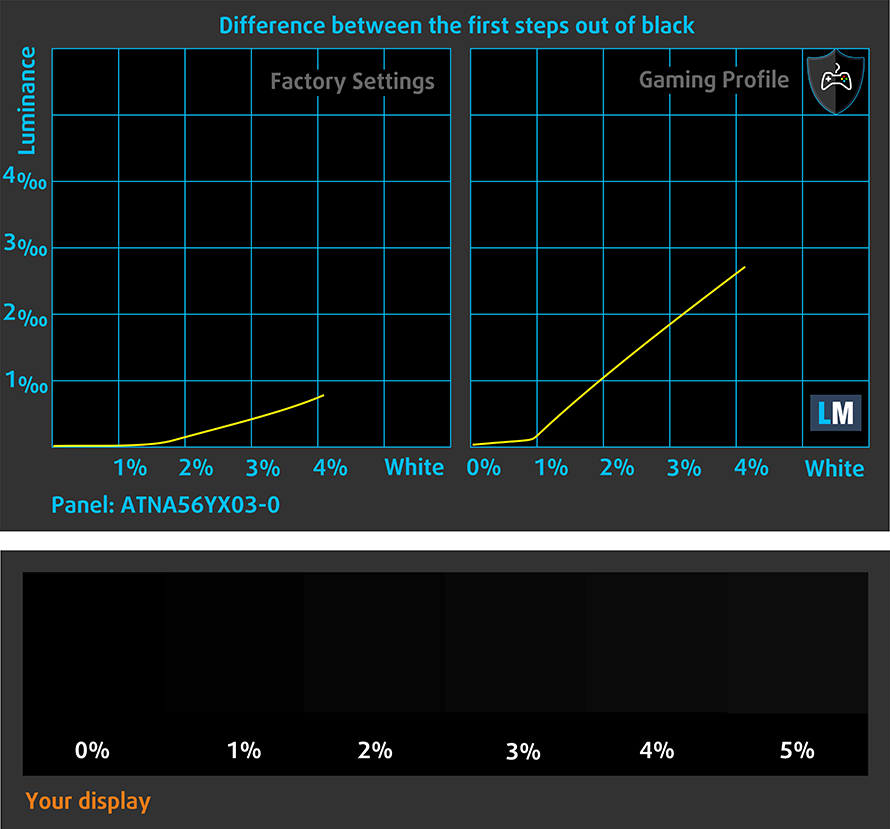
Response time (Gaming capabilities)
We test the reaction time of the pixels with the usual “black-to-white” and “white-to-black” method from 10% to 90% and vice versa.
We recorded Fall Time + Rise Time = 3 ms – insane speed.
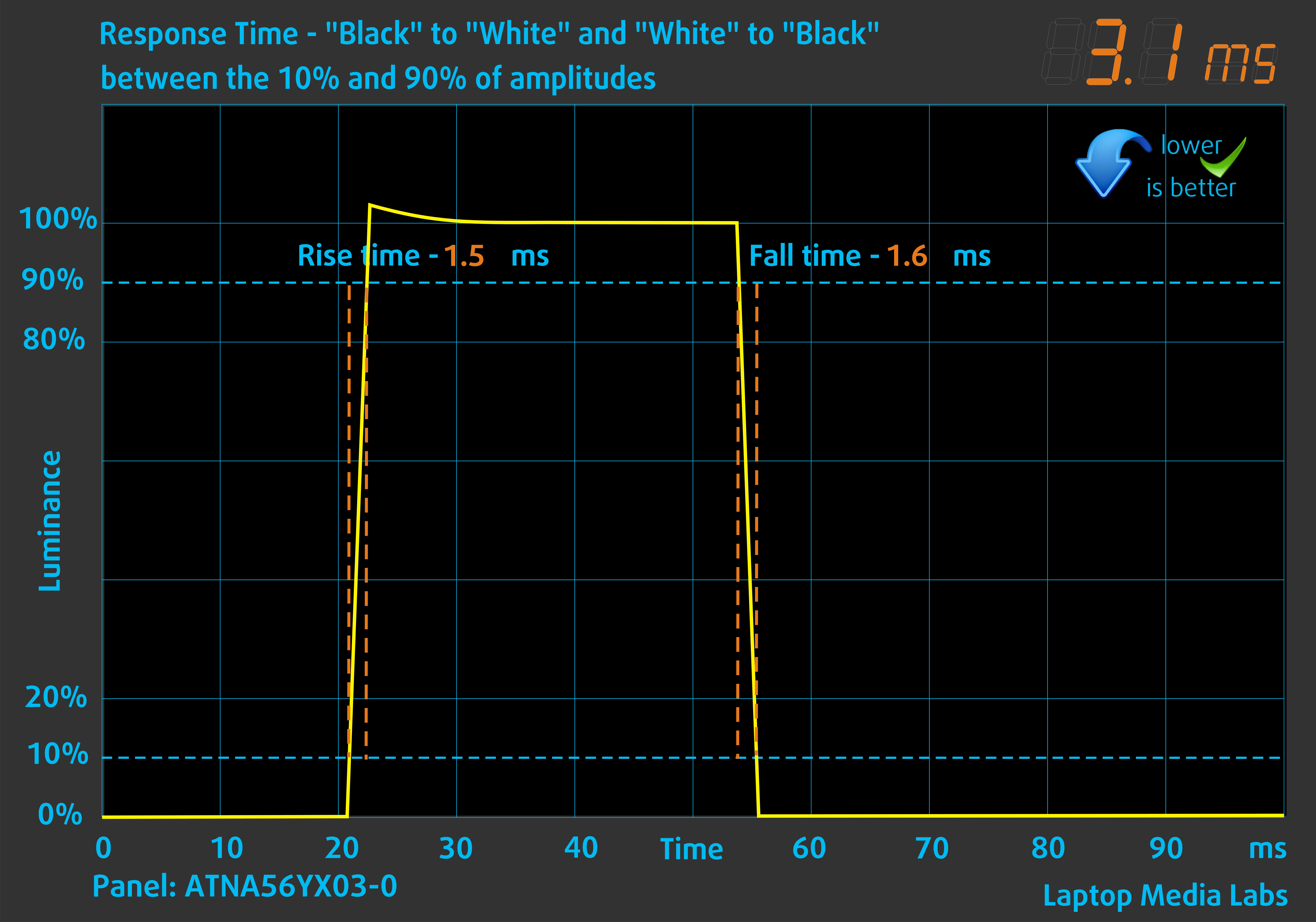
Health impact – PWM / Blue Light
PWM (Screen flickering)
Pulse-width modulation (PWM) is an easy way to control monitor brightness. When you lower the brightness, the light intensity of the backlight is not lowered, but instead turned off and on by the electronics with a frequency indistinguishable to the human eye. In these light impulses, the light/no-light time ratio varies, while brightness remains unchanged, which is harmful to your eyes. You can read more about that in our dedicated article on PWM.
ASUS ZenBook Pro 15 OLED (UM535)’s panel uses low-frequency PWM for brightness adjustment up until 98 nits. Afterwards, we detected small pulsations, which makes the display relatively safe in this aspect (after 98 nits).
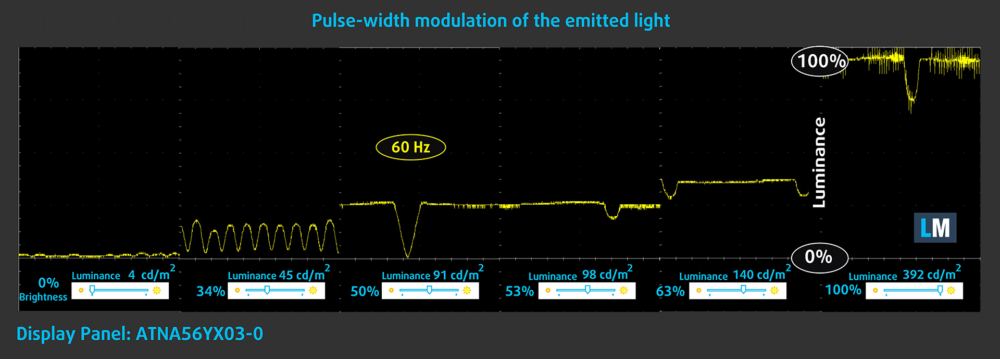
Blue light emissions
Installing our Health-Guard profile not only eliminates PWM but also reduces the harmful Blue Light emissions while keeping the colors of the screen perceptually accurate. If you’re not familiar with the Blue light, the TL;DR version is – emissions that negatively affect your eyes, skin, and your whole body. You can find more information about that in our dedicated article on Blue Light.
Buy our profiles
Since our profiles are tailored for each individual display model, this article and its respective profile package are meant for ASUS ZenBook Pro 15 OLED (UM535) configurations with 15.6″ Samsung ATNA56YX03-0 (SDC4161) (1920 x 1080p) AMOLED panel.
*Should you have problems with downloading the purchased file, try using a different browser to open the link you’ll receive via e-mail. If the download target is a .php file instead of an archive, change the file extension to .zip or contact us at [email protected].
Read more about the profiles HERE.
In addition to receiving efficient and health-friendly profiles, by buying LaptopMedia's products you also support the development of our labs, where we test devices in order to produce the most objective reviews possible.

Office Work
Office Work should be used mostly by users who spend most of the time looking at pieces of text, tables or just surfing. This profile aims to deliver better distinctness and clarity by keeping a flat gamma curve (2.20), native color temperature and perceptually accurate colors.

Design and Gaming
This profile is aimed at designers who work with colors professionally, and for games and movies as well. Design and Gaming takes display panels to their limits, making them as accurate as possible in the sRGB IEC61966-2-1 standard for Web and HDTV, at white point D65.

Health-Guard
Health-Guard eliminates the harmful Pulse-Width Modulation (PWM) and reduces the negative Blue Light which affects our eyes and body. Since it’s custom tailored for every panel, it manages to keep the colors perceptually accurate. Health-Guard simulates paper so the pressure on the eyes is greatly reduced.
Get all 3 profiles with 33% discount
Sound
ASUS ZenBook Pro 15 OLED (UM535)’s Harman Kardon speakers produce a sound of good quality. Its low, mid, and high tones are clear of deviations.
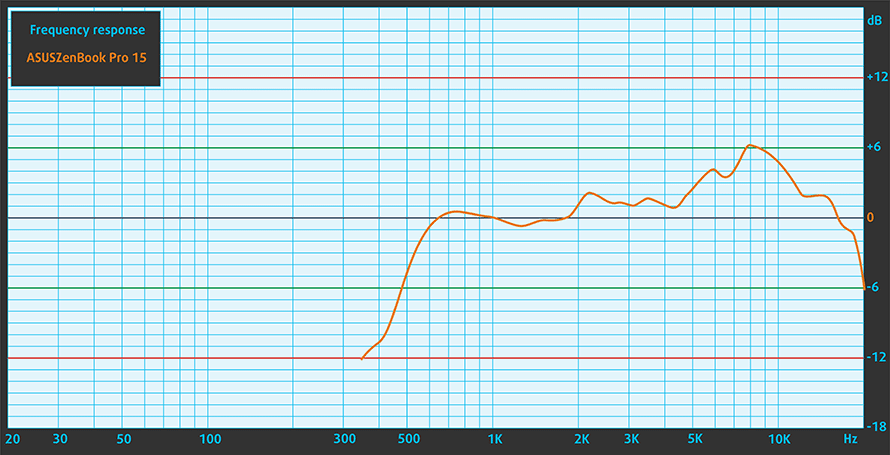
Drivers
All drivers and utilities for this notebook can be found here: https://www.asus.com/Laptops/For-Home/Zenbook/Zenbook-Pro-15-OLED-UM535-AMD-Ryzen-5000-Series/HelpDesk_Download/
Battery
Now, we conduct the battery tests with Windows Better performance setting turned on, screen brightness adjusted to 120 nits, and all other programs turned off except for the one we are testing the notebook with. This laptop’s huge 96Wh battery delivers 17 hours and 13 minutes of Web browsing, or 16 hours and 26 minutes of video playback.
In order to simulate real-life conditions, we used our own script for automatic web browsing through over 70 websites.
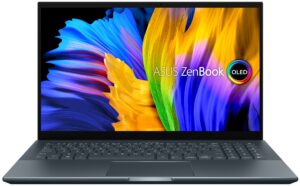
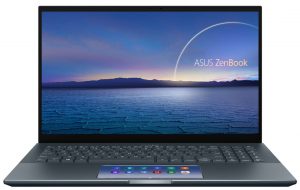
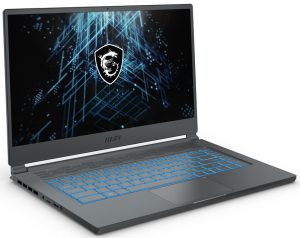
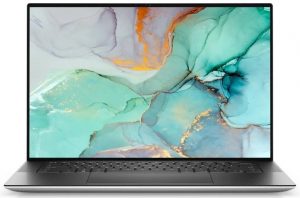
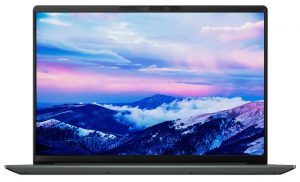
For every test like this, we use the same video in HD.





CPU options
You can get this notebook with either the Ryzen 7 5800H or the Ryzen 9 5900HX.
Results are from the Cinebench R23 CPU test (the higher the score, the better)
Results are from our Photoshop benchmark test (the lower the score, the better)
ASUS ZenBook Pro 15 OLED (UM535) CPU variants
Here you can see an approximate comparison between the CPUs that can be found in the ASUS ZenBook Pro 15 OLED (UM535) models on the market. This way you can decide for yourself which ASUS ZenBook Pro 15 OLED (UM535) model is the best bang for your buck.
Note: The chart shows the cheapest different CPU configurations so you should check what the other specifications of these laptops are by clicking on the laptop’s name / CPU.
Results are from the Cinebench R23 CPU test (the higher the score, the better)
Results are from our Photoshop benchmark test (the lower the score, the better)
GPU options
In terms of graphics, the choice is limited to the RTX 3050 Ti with a TGP of 50W.
Results are from the 3DMark: Time Spy (Graphics) benchmark (higher the score, the better)
Results are from the 3DMark: Fire Strike (Graphics) benchmark (higher the score, the better)
Results are from the 3DMark: Wild Life benchmark (higher the score, the better)
Results are from the Unigine Superposition benchmark (higher the score, the better)
Gaming tests
| Metro Exodus | Full HD, Low (Check settings) | Full HD, High (Check settings) | Full HD, Extreme (Check settings) |
|---|---|---|---|
| Average FPS | 93 fps | 44 fps | 21 fps |
| Borderlands 3 | Full HD, Medium (Check settings) | Full HD, High (Check settings) | Full HD, Badass (Check settings) |
|---|---|---|---|
| Average fps | 77 fps | 57 fps | 45 fps |

| Shadow of the Tomb Raider (2018) | Full HD, Lowest (Check settings) | Full HD, Medium (Check settings) | Full HD, High (Check settings) |
|---|---|---|---|
| Average | 121 fps | 80 fps | 72 fps |

| Tom Clancy’s Ghost Recon Wildlands | Full HD, Medium (Check settings) | Full HD, High (Check settings) | Full HD, Very High (Check settings) |
|---|---|---|---|
| Average fps | 74 fps | 67 fps | 59 fps |
Temperatures and comfort
Max CPU load
In this test we use 100% on the CPU cores, monitoring their frequencies and chip temperature. The first column shows a computer’s reaction to a short load (2-10 seconds), the second column simulates a serious task (between 15 and 30 seconds), and the third column is a good indicator of how good the laptop is for long loads such as video rendering.
Average core frequency (base frequency + X); CPU temp.
| AMD Ryzen 7 5800H (45W TDP) | 0:02 – 0:10 sec | 0:15 – 0:30 sec | 10:00 – 15:00 min |
|---|---|---|---|
| ASUS ZenBook Pro 15 OLED (UM535) | 3.36 GHz (B+5%) @ 74°C | 3.32 GHz (B+4%) @ 74°C | 3.23 GHz (B+1%) @ 82°C |
| Lenovo IdeaPad 5 Pro (16″) | 3.19 GHz @ 76°C | 3.07 GHz @ 79°C | 3.16 GHz @ 84°C |
| Dell G15 5515 | 3.29 GHz (B+3%) @ 74°C | 3.14 GHz @ 74°C | 3.21 GHz (B+0%) @ 82°C |
| HP Victus 16 (16-e0000) | 3.29 GHz (B+3%) @ 80°C | 3.20 GHz (B+0%) @ 80°C | 3.27 GHz (B+2%) @ 89°C |
| HP Omen 15 (2021, 15-en1000) | 3.33 GHz (B+4%) @ 78°C | 3.33 GHz (B+4%) @ 85°C | 3.42 GHz (B+7%) @ 88°C |
| ASUS ROG Strix SCAR 15 G533 | 3.43 GHz (B+7%) @ 76°C | 3.35 GHz (B+5%) @ 80°C | 3.47 GHz (B+8%) @ 82°C |
| ASUS ROG Zephyrus Duo 15 SE (GX551) | 3.93 GHz (B+23%) @ 81°C | 3.82 GHz (B+19%) @ 86°C | 3.78 GHz (B+18%) @ 93°C |
| ASUS TUF A17 (FA706) 2021 | 3.42 GHz (B+7%) @ 74°C | 3.34 GHz (B+4%) @ 78°C | 3.35 GHz (B+5%) @ 84°C |
To be completely frank, the ZenBook Pro 15 OLED (UM535) delivers a decent performance out of its Ryzen 7 5800H CPU. It even beats some gaming devices like the Dell G15 5515.
Real-life gaming
| NVIDIA GeForce RTX 3050 Ti | GPU frequency/ Core temp (after 2 min) | GPU frequency/ Core temp (after 30 min) | GPU frequency/ Core temp (Max fan) |
|---|---|---|---|
| ASUS ZenBook Pro 15 OLED (UM535) | 1530 MHz @ 66°C @ 50W | 1529 MHz @ 68°C @ 50W | – |
| HP Pavilion Gaming 15 (15-dk2000) | 1613 MHz @ 65°C @ 60W | 1576 MHz @ 73°C @ 60W | – |
| MSI Sword 15 | 1633 MHz @ 73°C @ 60W | 1605 MHz @ 79°C @ 60W | 1644 MHz @ 69°C @ 60W |
| Dell XPS 15 9510 | 1187 MHz @ 74°C @ 40W | 1293 MHz @ 75°C @ 44W | – |
| Dell G15 5511 | 1882 MHz @ 71°C @ 88W | 1878 MHz @ 72°C @ 89W | – |
| Dell G15 5515 | 1857 MHz @ 76°C @ 80W | 1850 MHz @ 77°C @ 80W | – |
| Acer Nitro 5 (AN515-57) | 1616 MHz @ 70°C @ 66W | 1607 MHz @ 72°C @ 65W | 1632 MHz @ 69°C @ 66W |
| MSI Katana GF76 | 1619 MHz @ 76°C @ 60W | 1594 MHz @ 82°C @ 60W | 1632 MHz @ 70°C @ 60W |
While the 50W TGP of this graphics card is not a big challenge, it is still worth noting that the cooling solution was well-calculated.
Gaming comfort
If you use the Performance preset as we did, you should be expecting a high noise level during gaming or heavy use. Thankfully, the warmest spot on the base never exceeded 40°C.
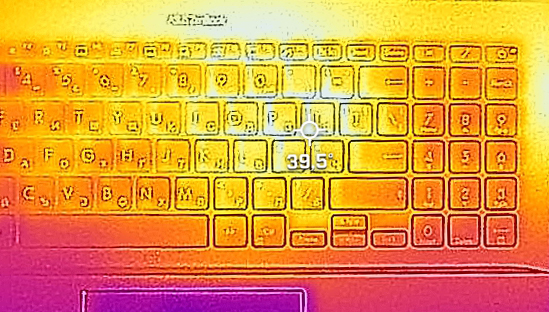
Verdict
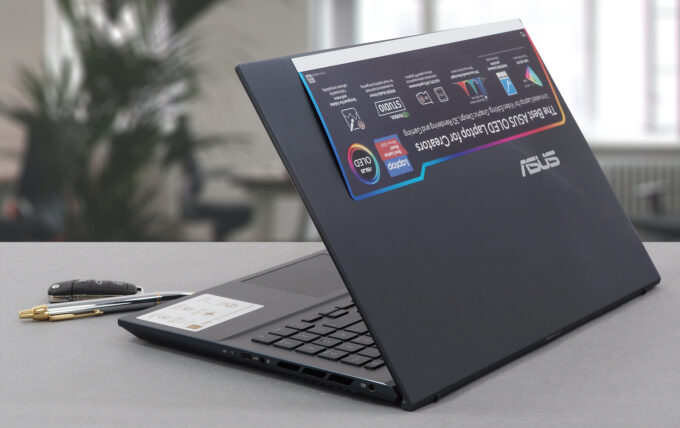 This device has been designed to be a tool for young content creators, who need a lot of performance and stability, without the need to tinker with their notebook. It is basically plug-and-play and delivers what it needs to. This includes a great performance from both the CPU and the GPU. And while the RTX 3050 Ti is no beast, it is still great for 4K video editing, and playing pretty much all current AAA titles at 1080p.
This device has been designed to be a tool for young content creators, who need a lot of performance and stability, without the need to tinker with their notebook. It is basically plug-and-play and delivers what it needs to. This includes a great performance from both the CPU and the GPU. And while the RTX 3050 Ti is no beast, it is still great for 4K video editing, and playing pretty much all current AAA titles at 1080p.
We found the battery life here to be astonishing. No, really, we got more than 17 hours of Web browsing, or about 16 hours and a half of video playback on a single charge. This is crazy!
ASUS ZenBook Pro 15 OLED (UM535)’s OLED panel has a Full HD resolution, pretty high maximum brightness, and comfortable viewing angles. It offers blazingly quick pixel-response times, as well as a practically infinite contrast ratio. Moreover, it covers 100% of both the sRGB and the DCI-P3 color gamuts, which results in a punchy and colorful image. Also, it doesn’t use aggressive PWM above 98 nits, supports HDR True Black 600, and its colors are PANTONE Validated.
To be completely honest with you, the ports are where we think the device can be improved. Internally, there is only one M.2 PCIe x4 slot for storage and no memory expansion slots. Keep in mind that ASUS offers options with either 16 or 32GB of RAM, so choose carefully before buying.
And on the outside, yes, there is a full-sized SD card reader, a USB Type-A 3.2 (Gen. 1) port, and an HDMI 2.0b connector. However, the USB Type-C port is data transfer only.
Speaking of the externals, this laptop has outstanding body strength. It barely moves when you twist it. And surprisingly, the same can be said about the lid as well.
As with every ZenBook out there, this one also features the AI noise canceling ability. It goes both ways, so you can remove unneeded sounds from the sound you receive, or from your surroundings. Not bad if you are on conference calls.
Thankfully, this device features an HD camera, but the more intriguing factor here is the IR face recognition sensor. It allows you to basically log into your device without the need to even touch it.
At the end of the day, the ZenBook Pro 15 OLED (UM535) is one solid machine. One of its direct competitors is Dell’s XPS 15 9510, which is significantly more expensive and has an inferior cooling solution.
You can check the prices and configurations in our Specs System: https://laptopmedia.com/series/asus-zenbook-pro-15-oled-um535/
Pros
- Strong metal build
- Good input devices
- 100% sRGB and DCI-P3 coverage
- HDR True Black 600 support
- Amazing battery life
- Decent performance
- IR face recognition
- HDMI 2.0b + SD card
Cons
- USB Type-C port is data transfer only
- Soldered memory
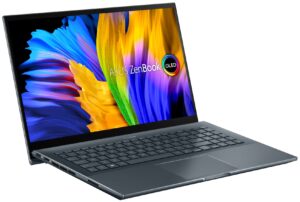
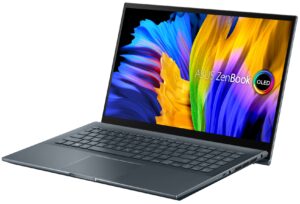

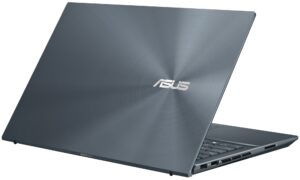
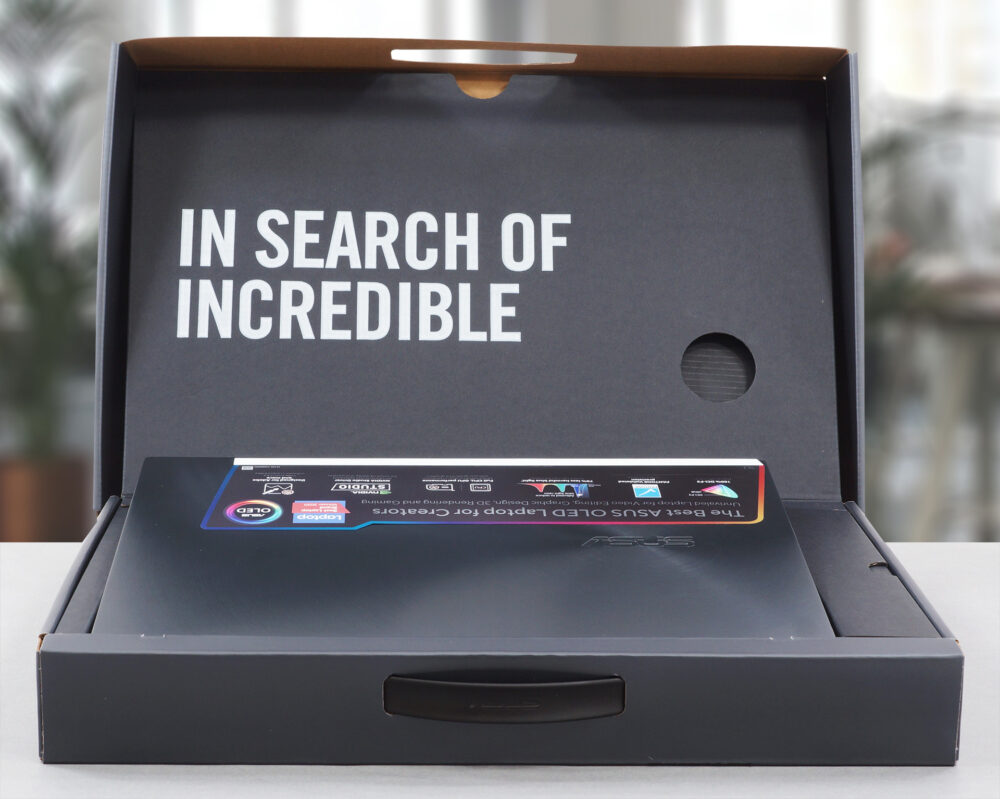

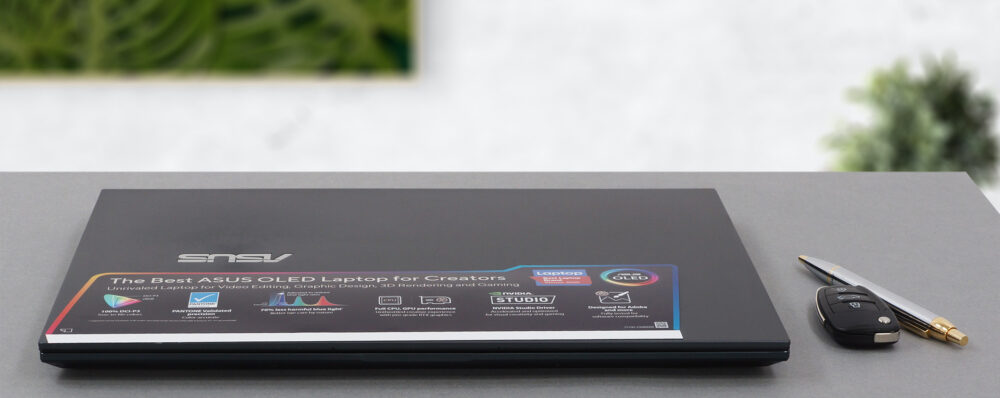

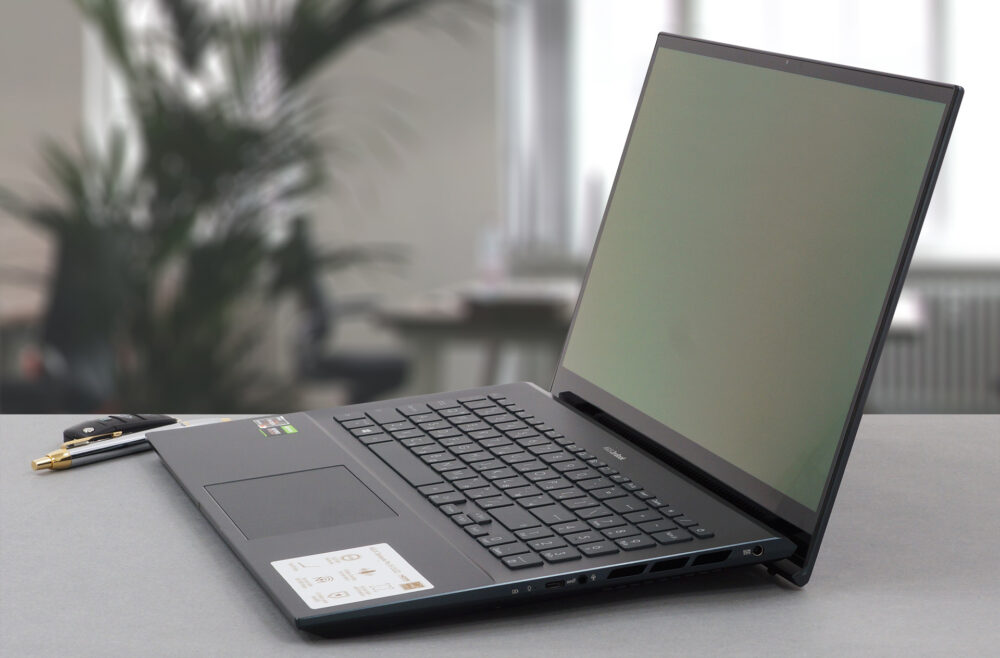
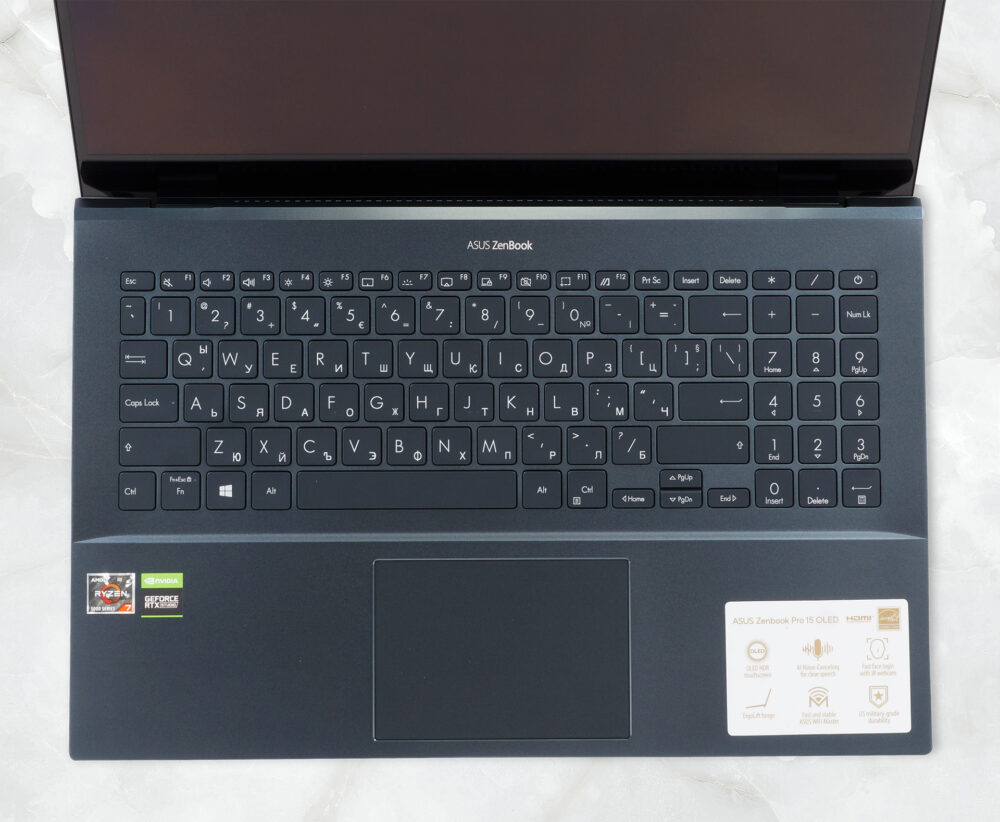
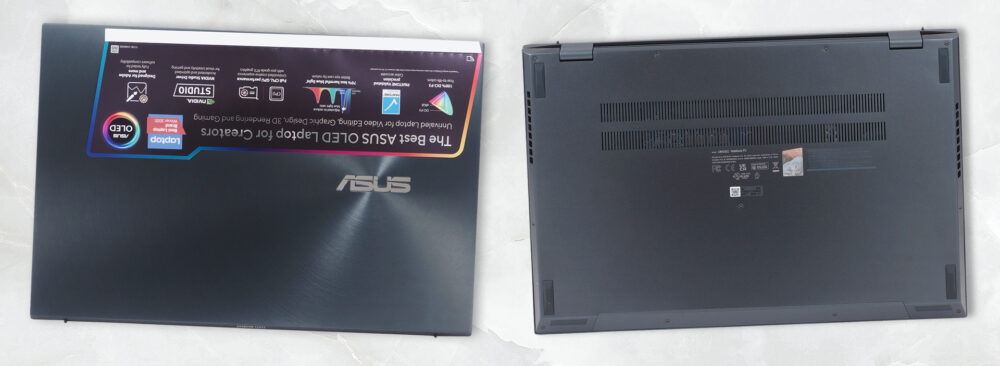


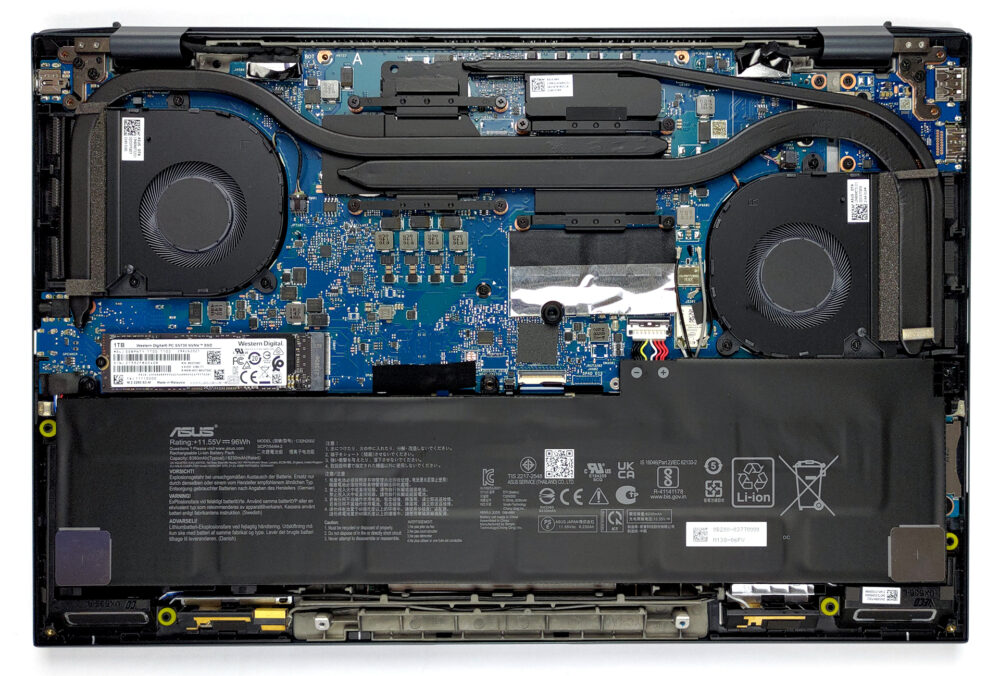

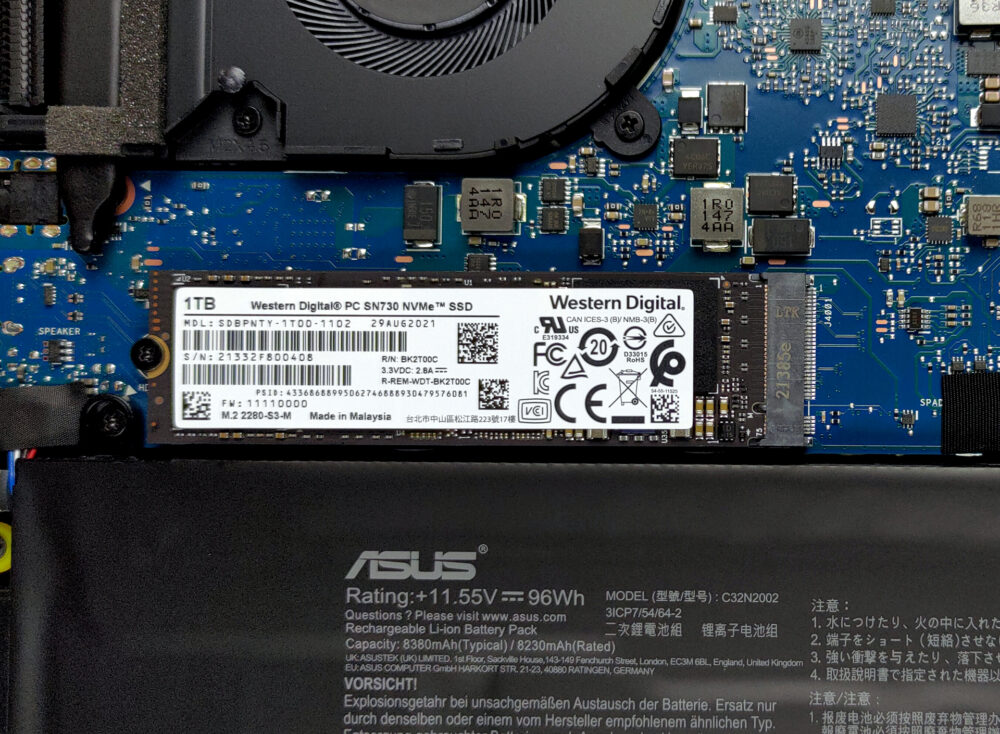
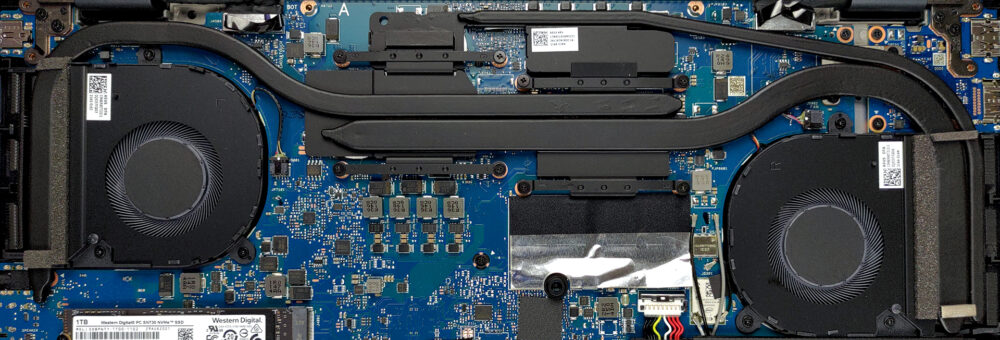
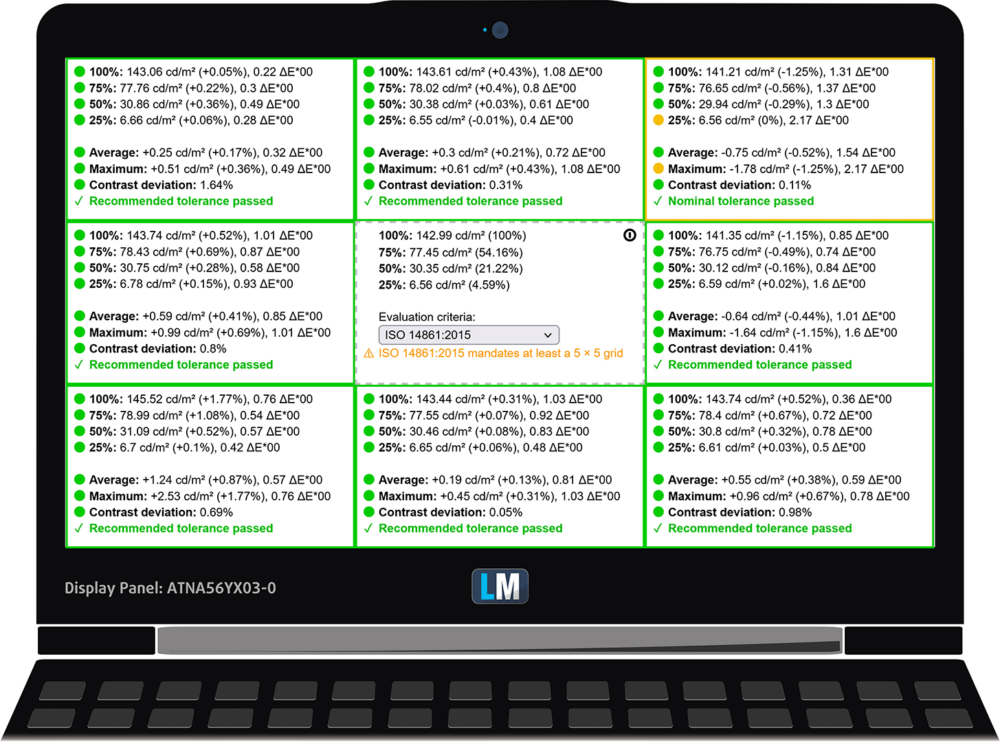
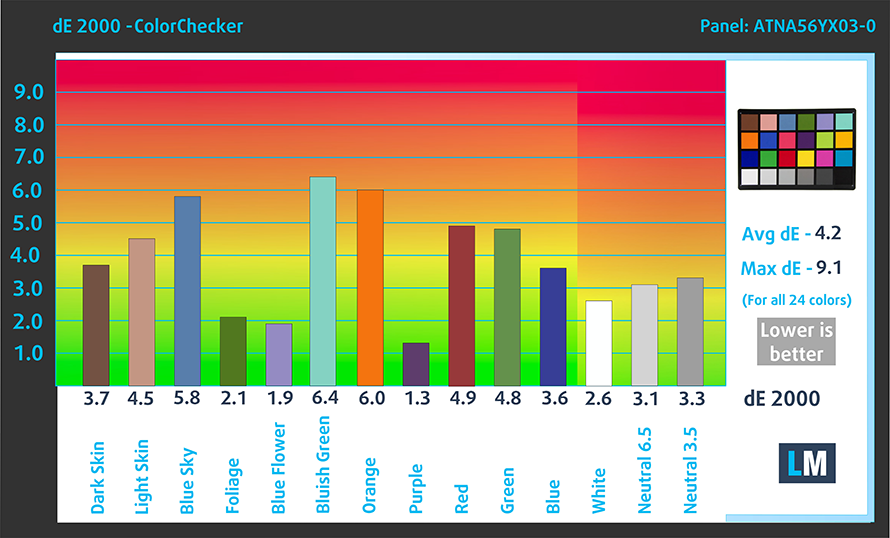
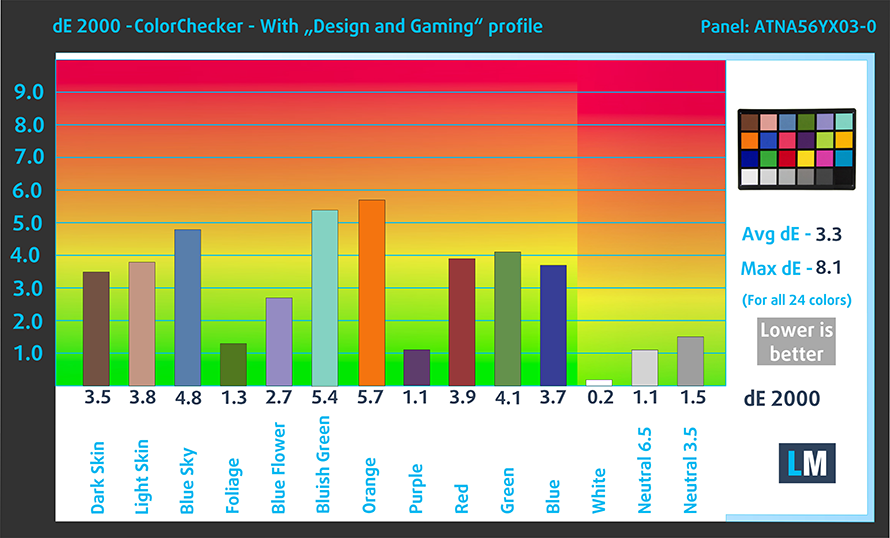

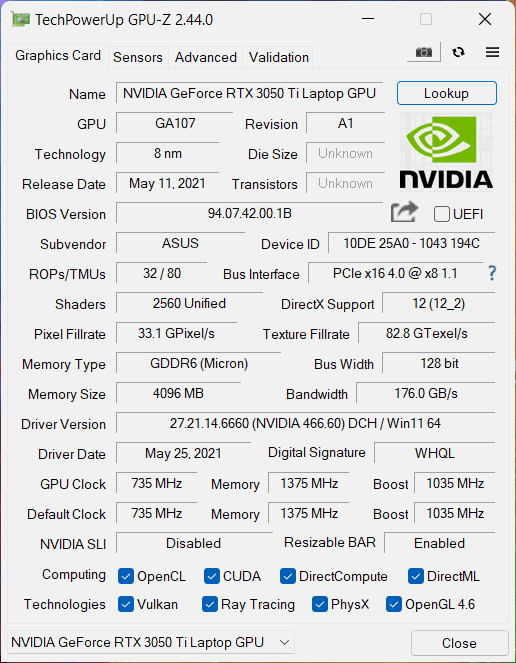









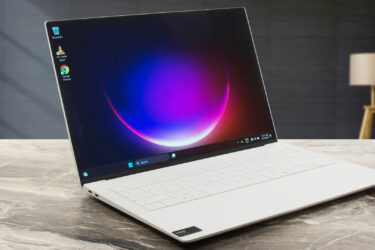
Wonderful review. Thanks👍